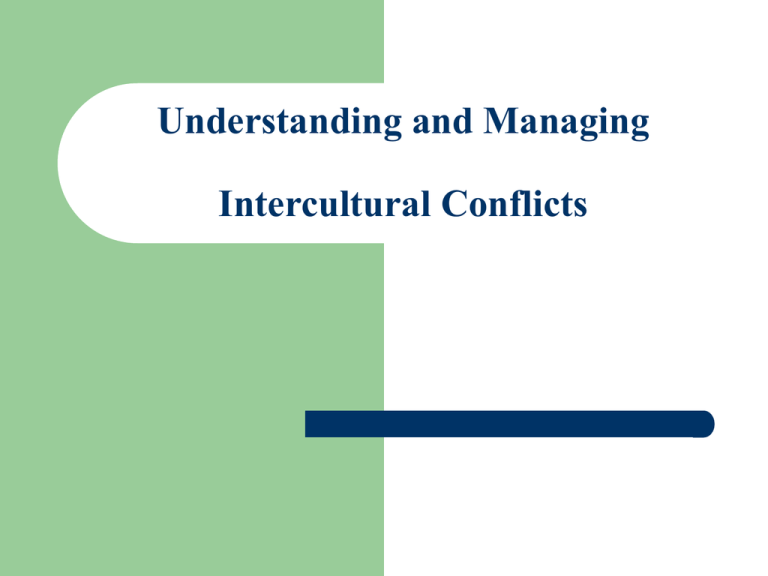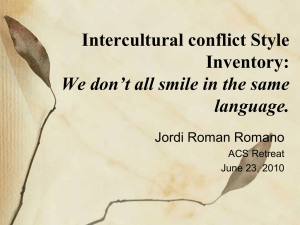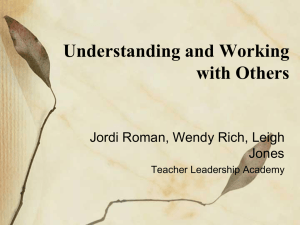Defining conflict styles
advertisement

Understanding and Managing Intercultural Conflicts Major topics Defining intercultural conflicts Causes of intercultural conflicts Communication conflict styles Managing intercultural conflicts Practical suggestions Intercultural conflict is the implicit or explicit emotional struggle or frustration between persons of different cultures over perceived incompatible values, norms, face orientations, goals, scarce resources, processes, and/or outcomes in a communication situation. (Ting-Toomey and Oetzel, 2001) Conflict is indeed a cultural challenge and, simultaneously, an opportunity for us to learn about diverse approaches in framing a conflict situation and in honing our constructive conflict management skills. (Ting-Toomey and Oetzel, 2001) The study of intercultural conflict is about the study of conflict that evolves, at least in part, because of cultural group membership differences. It is about acquiring the necessary knowledge and skills to manage such differences constructively and creatively. Causes of Intercultural Conflicts 跨文化冲突的原因 1. Culture-based conflict lenses Independent-self conflict lens views conflict from a(n): a. Content conflict goal lens (tangible conflict issues) b. Clear win-lose conflict approach c. "Doing" angle (something broken needs fixing) d. Outcome-driven mode (clear resolution needed) Interdependent-self conflict lens views conflict from a: a. Relational process lens (relationship and feeling issues) b. Win-win relational approach (feelings, "faces" both saved) c. "Being" angle (repair relational trust) d. Long-term compromise negotiation mode (no "winner"/"loser") Individualistic conflict lens Collectivistic conflict lens • • • • • • • • Process-focused • Relational goal-oriented • Being-centered • Use communal norms • Other-face concern • High-context conflict styles • Avoiding/obliging behaviors Conflict appropriateness Outcome-focused Content-goal-oriented Doing-centered Use personal equity norms Self-face concern Low-context conflict style Competitive/dominating behaviors • Conflict effectiveness 2. Intercultural conflict perceptions There are three primary perception features of intercultural conflict: Involves intercultural perceptions (i.e., ethnocentrism, stereotypes) Ethnocentric perceptions add biases to conflict attribution process Attribution process compounded by different conflict styles 3. Intercultural conflict goal issues Content goals: practical issues external to individuals involved Relational conflict goals: relational definition, desire in interaction Identity-based goals: face-saving and face-honoring issues a. Cultural identity: how person defines self culturally, ethnically, linguistically, religiously b. Social identity: profession, age, social class, and gender c. Personal identity: personal self-esteem, self-respect issues 4. Perceived scarce resources Conflict resources: tangible rewards that people strive for in conflict Tangible resources: items, time, scarce commodities, etc. Intangible resources: desires or emotional needs (security, etc.) Three techniques to negotiate scarce resources: a. Differentiation: acknowledge different perspectives and divide up the large puzzle into different pieces b. Expansion: search for alternative paths or creative solutions c. Compensation: offer exchanges or concessions for conflict issues each values differently Face and Facework Face refers to a person’s sense of favorable selfworth or self-image experienced during communicative situations. It is an emotional extension of the self-concept. Self-face, other-face and mutual-face One’s face can be threatened, enhanced, undermined, and bargained over both emotionally and cognitively. Facework refers to the various ways people deal with conflict and face. It refers to the communicative strategies employed to manage one’s own face or to support or challenge another’s face. Face work can be employed to initiate, manage or terminate conflict. Conflict Communication Style Defining conflict styles 1. Face: socially approved self-image and other-image issues 2. Facework: verbal and nonverbal strategies to maintain, defend, or upgrade our social image (or attack or defend others') 3. Conflict communication style: patterned responses to conflict 4. Three approaches to studying conflict styles: a. Dispositional: conflict style due to socialization, disposition b. Situational: conflict topic and situation shapes styles c. Systems: integrates a and b. People have predominant styles but modify based on situation, etc. Five-style conflict grid conceptualizes five conflict style tendencies a. Dominating (or competitive/controlling): push for one‘s own position above others’ conflict interest b. Avoiding: dodge conflict topic, party, or situation c. Obliging (or accommodating): concern for others‘ conflict interest above one’s own conflict position d. Compromising: give-and-take concession to reach midpoint e. Integrating (or collaborative): concern for both oneself and others‘ interest Cross-cultural conflict styles 1. Face-negotiation theory: how individualism-collectivism value patterns influence use of diverse face concerns and conflict styles in different cultures 2. Individualists: self-face oriented, direct, low-context style 3. Collectivists: other-/mutual-face oriented, indirect, highcontext style 4. Independent-self individuals: competitive/dominating conflict styles 5. Interdependent-self individuals: avoiding, obliging, integrating, and compromising styles Cross-ethnic conflict styles and facework 1. African American conflict styles: energetic, nonverbally animated, emotionally expressive 2. Asian American conflict styles: Confucianism influence (roles, status, collective face-saving), avoiding, obliging, sometimes "silence" 3. Latino/a American conflict styles: tactfulness important, avoidance sometimes preferred over head-on confrontation 4. Native American conflict styles: verbal restraint, otherand mutual-face sensitivity, deliberate silence, ask elder for wisdom Competent Intercultural Conflict Skills 1. Facework management Core issues of protecting our communication identity during conflict and dealing with others' communication identity Self-oriented face-saving behaviors: to regain or defend one's image after threats to face or face loss Other-oriented face-giving behaviors: to support others' face claims and help prevent further face loss or restore face Giving face: not humiliating others' communication identity in public 2. Mindful listening Mindful listening: learning to listen responsively or ting (a Chinese word that means "attending mindfully with our ears, eyes, focused heart") Creating new categories: learn to apply culture-sensitive concepts to interpret conflict variation behaviors Paraphrasing skills involve: a. verbally summarizing content meaning of the message b. nonverbally echoing your interpretation of emotional meaning 3. Cultural empathy: learned ability to understand others' self-experiences, convey understanding effectively 4. Mindful reframing Highly creative, mutual-face honoring skill Mindful process of using language to change how a person defines or thinks about experiences and views the conflict situation Face Negotiation Theory (1) people in all cultures try to maintain and negotiate face in all communication situations; (2) the concept of face is especially problematic in emotionally threatening or identity-vulnerable situations when the situated identities of the communicators are called into question; (3) the cultural value spectrums of individualism-collectivism and small/large power distance shape facework concerns and styles; (4) individualism and collectivism value patterns shape members’ preferences for self-oriented face concern (i.e., verbal direct tendency) versus other-oriented or mutualoriented face concern (verbal indirect-accommodating tendency); (5) small and large power distance value patterns shape members’ preferences for horizontal-based facework (i.e., informal interaction) versus vertical-based facework (i.e., formal interaction); (6) the value dimensions, in conjunction with individual, relational, topical, and situational factors influence the use of particular facework behaviors in particular cultural conflict scenes; and (7) intercultural facework competence refers to the optimal integration of culture-sensitive knowledge, mindfulness, and flexible communication skills in managing vulnerable identity-based conflict situations appropriately, effectively, and adaptively. Case Study Who gets the job? Intercultural Conflict Competence ICC refers to applying the intercultural knowledge we have learned in a skillful manner. There are 4 criteria to be a competent communicator: Appropriateness Effectiveness Satisfaction Productivity Practical Suggestions A. To deal constructively with conflict in a collectivistic culture, individualists need to do the following: 1. Be mindful of mutual face-saving premises 2. Practice patient, mindful observation and limit why questions 3. Mindful listening skills, attend to others‘ identities and relational expectations B. In encountering a conflict situation in an individualistic culture, collectivists need to do the following: 1. Assertive conflict behavior, state a clear thesis then develop key points 2. Use “I” statements and more content-clarification questions 3. Use active listening skills; do not rely solely on nonverbal signals.







